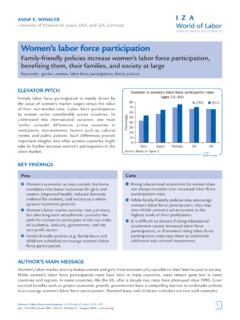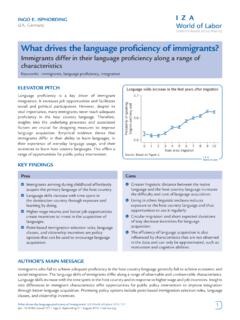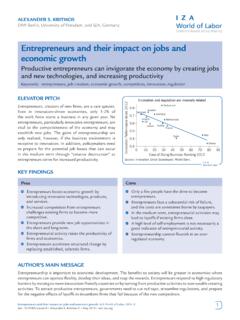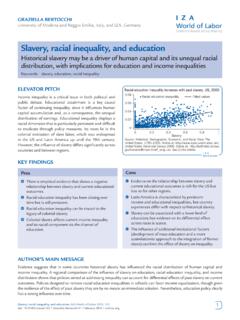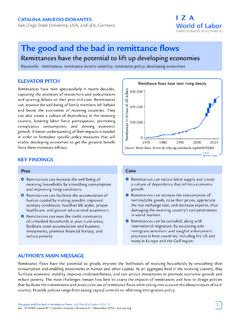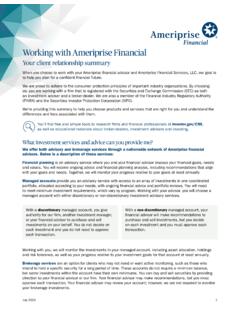Transcription of Performance measures and worker productivity
1 Jan SauermannStockholm University, Sweden, IZA, Germany, and Research Centre for Education and the Labour market (ROA), the NetherlandsPerformance measures and worker productivity . IZA World of Labor 2016: 260doi: | Jan Sauermann | May 2016 | Pros Performance measures provide detailed information about worker productivity . To inform about a wide range of questions, such as how incentives work, how peer effects operate, or how workers accumulate human capital, Performance measures can be useful. Reliable Performance measures are needed to design appropriate contracts and improve produc tivit y. Performance measures are increasingly available for low- and high-skilled jobs, as well as for jobs in the private and public PITCHM easuring workers productivity is important for public policy and private-sector decision-making. Due to a lack of reliable methods to determine workers productivity , firms often use specific Performance measures , such as how different incentives affect employees behavior.
2 The public sector also uses these measures to monitor and evaluate personnel, such as teachers. To select the right Performance measures , and as a result design better employment contracts and improve productivity , policymakers and managers need to understand the advantages and disadvantages of the available S maIn meSS aGeMeasures of worker productivity can give important insights into how workers perform and how workplaces should be organized. Direct measures of productivity are used to study a range of questions, such as the effects of incentives on workers productivity , the influence of peers on behavior, or the accumulation of human capital on the job. For these and related questions, it is important to select appropriate Performance measures . This choice is critical, as relying on inappropriate measures can lead to the design of inefficient incentives, poor employment contracts, or wrong policy There is no universal definition of worker productivity ; measures of worker productivity typically depend on the setting in which they are collected.
3 worker productivity is usually multidimensional, but it is generally not possible to measure all dimensions. If the wrong Performance measures are chosen to evaluate workers, distortions can create negative effects on worker productivity . For settings in which Performance is only observable at the team level, it is not always possible to estimate individual contributions to team measures and worker productivityChoosing the right Performance measures can inform and improve decision-making in policy and managementKeywords: worker productivity , Performance measures , human resource managementKeY FInDInGSGrowing emphasis on direct measures of workerproductivityNote: Three-year moving average of the number of publications in the top ten economics journals that use direct measures of worker productivity (AER, QJE, ECA, JPE, RES, JEEA, JOLE, AEJA, JHR, EJ).Source: Author s own calculations based on data taken from of publications4321019901995200020052010201 5 IZA World of Labor | May 2016 | Sauermann | Performance measures and worker productivity mOTIVaTIOnPoliticians and managers often make decisions that involve the behavior of individuals at work.
4 For example, managers decide how to establish optimal incentives or how much training to provide for employees, while policymakers make decisions about the regulation of working hours. To make informed choices about these kinds of issues, it is important to know how these decisions will affect workers behavior, in terms of their conceptualization of worker productivity has gained increasing attention in the last decade. Direct measures are now commonly used in research within economics and related fields; they frequently serve as approximations of workers productivity . This paper describes how worker productivity can be defined and provides an overview of the most up-to-date Performance measurements available in order to help decision makers choose the right ones for their specific OF PrOS anD COnSDefining worker productivityIn a general sense, productivity can be defined as the ratio between a measure of output and a measure of input.
5 The productivity of workers could thus be measured as an output, sales or units produced, relative to an input, the number of hours worked or the cost of labor. Traditionally, labor productivity is derived from aggregate measures at the firm level, value-added per worker . To account for differences between labor inputs, this measure has often been disaggregated according to various labor types, low-, medium-, and high-skilled labor. However, even at this disaggregated level, measures of labor productivity can mask considerable variation with respect to workers underlying productivity , either between workers, or over time. At the individual ( worker ) level, studies frequently use input measures , such as workers wages, as a measure of productivity . Although correlated with the underlying productivity of the individual worker , there are several reasons why wages do not directly reflect the worker s actual productivity .
6 For instance, institutional settings, such as those resulting from collective agreements, often make wages dependent on age or tenure rather than productivity . This is complicated by the fact that most data do not contain information on hourly wages, but rather on monthly wages. Variations in monthly wages might not only reflect differences in productivity , but also in the number of working hours. Furthermore, wage growth is often determined by supervisor evaluations, which might reflect bias due to gender or migration labor productivity and wages have their shortcomings when it comes to assessing workers productivity . Ideally, one would like to observe productivity for each individual worker at each point in time. In reality, however, output is rarely observable at the individual level for a reasonable cost, thus making it practically impossible to calculate each individual s productivity . Instead, firms use individual measures of workers Performance as an approximation of their productivity .
7 Most occupations have one or more metrics that can be used to evaluate how well workers perform. These measures , also known as key Performance indicators (KPIs), are regularly used for internal evaluation and monitoring in firms. Figure 1 shows evidence from the World Management Survey on the extent to which firms collect Performance measures and use them for monitoring World of Labor | May 2016 | Sauermann | Performance measures and worker productivity There is a key set of properties that should be met when assessing measures of worker produc-tivity:(1) Objectivity: measures should be objective, as opposed to subjective, with respect to supervisor or peer ratings.(2) Availability: measures need to be available at the individual ( worker ) level ( not on aggregated levels such as team or firm level).(3) Comparability: tasks and measurements should be the same across workers and time.(4) Quality and controllability: workers should have sufficient influence on the outcome, by choosing their own effort precise measurement of Performance across workers and over time allows policymakers to address important economic questions, such as how incentives affect workers behavior, Figure 1.
8 Use of direct Performance measurement across countriesNote: Firms managers are asked to assess whether Performance is tracked using meaningful metrics and with appropriate regularity, measured on a scale from 1 (lowest) to 5 (highest).Source: World Management Survey, 2004 2014. Online at: of IrelandNorthern IrelandChileArgentinaChinaSingaporePolan dBrazilSpainPortugalJapanItalyNew ZealandMexicoAustraliaGreat BritainGermanyUSCanadaFranceSwedenIZA World of Labor | May 2016 | Sauermann | Performance measures and worker productivity how the presence of peers affects workers productivity , or how workers accumulate human capital in 2 provides examples of workers productivity measures which were used in studies published in leading economics journals, and whose findings can be used to inform policymakers and practitioners. The figure shows that Performance is not only measurable for low-skilled jobs with routine tasks, but that it can also be measured for rather knowledge-intensive, non-routine professions, such as lawyers, physicians, or 2.
9 Examples of measures of workers productivitySource: For full source details, see the complete list of references for this article at: care sectorPolitics and publicsectorSectorJob/taskWindshield installers: unitsinstalled per day [1], [2]Supermarket cashiers: numberof items scanned per second [3]Call agents: average length ofcalls [4]Lawyers: number of hours billed, new client revenue [5]Fruit pickers: kilograms of fruitspicked per day [6]Academic scientists: PhD thesisgets published in top journal,number of citations [7]Academic scientists: impactfactor weighted publications [8]Teachers: teacher value-added[9], [10]Paramedics: transport time,number of procedures [11]Politicians: number ofsubmitted bills [12]Navy recruiters: number andquality of recruits [13]FrequencyDaysSecondsWeeksYearsDays AnnualShifts(daily) MonthlyDirect measureor estimated?Firm sdatabaseFirm sdatabaseFirm sdatabaseSurvey-basedFirm sdatabaseUniversityarchivesPublicdatabas esEstimatedParamedics firm databaseGovernmentalsurveyNavy dataQuantity or qualitydimensionQuantityQuantityQuantity (qualitymeasure available)Quantity andqualityQuantityQuantity andqualityQuality adjustedoutputQuality adjustedoutputQuantity andqualityQuantity andqualityQuantity andqualityadvantages and disadvantages of measuring workers productivityFirms regularly use measures of workers Performance to approximate productivity .
10 Measuring workers Performance , however, is not always straightforward, or even possible, at a reasonable cost. Even though most occupations include some measures of Performance IZA World of Labor | May 2016 | Sauermann | Performance measures and worker productivity at the worker level, Figure 2 shows that there is no universal measure. Instead, the degree to which Performance can be monitored depends on the do Performance measures entail? worker Performance can be a function of many features, including the worker s effort, education, age, or tenure, and the firm s characteristics, such as work environment, wages, or incentives. An observed change in a worker s Performance might be due to several reasons, including factors outside of the worker s control. The two most common reasons are changes in the worker s skills, due to training programs or from learning on-the-job, and changes in effort provided by the worker , due to different incentives set by the management.
